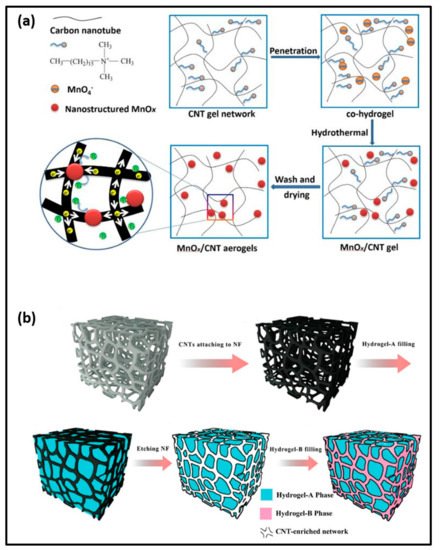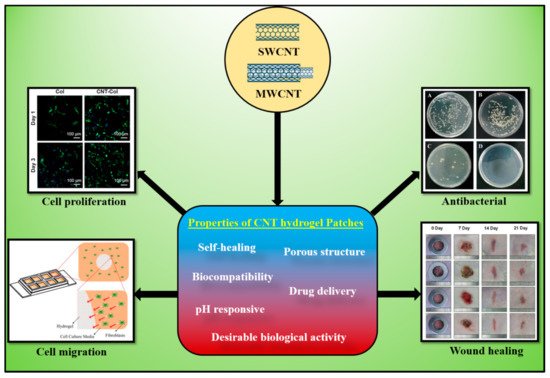The annual wound care costs are estimated to be several billion dollars, which constitute approximately 2–3% total expenditure on health
[1]. Wound healing is one of the most complex and essential treatments in the human body. Skin injury also occurs in daily life, where the skin loses its protective action, leading to the formation of a wound in the skin
[2]. Multiple cell types are required within the damaged skin layers to accelerate the healing process, such as hemostasis/inflammation, angiogenesis, proliferation, and remodeling. Several therapies are available for the wound-healing process
[3]. These therapies include both conventional and modern treatments. Some examples of modern and currently used treatments are stem cell therapy
[4], oxygen therapy
[5], nitric oxide therapy
[6], artificial dressing
[7], and growth factor therapy
[8]. Comparatively, conventional treatments include using natural substances such as plant extracts, honey, propolis, larvae, etc.
[9]. The treatments are effective when the healing materials are fabricated with excellent wound-healing potential. Different materials are developed for this process; still, few reports are available on more effective therapies
[2][10][2,10]. The incorporation of nanomaterials with biocompatible polymers has been an emerging area for wound-healing application. Commonly, two types of approaches are used where nanomaterials either act as drug or vehicle to deliver the drug. Materials such as silver, gold, zinc, gold copper, titanium, and terbium are used in the form of nanoparticles to act as a drug. Whereas, in another approach, nanomaterials are used to deliver antibiotics, growth factors, nucleic acids, and antioxidants
[11]. The design of effective materials for rapid wound healing is emerging, and nanomaterials-based hydrogels exhibited an improved healing process
[12][13][12,13]. The utilization of inorganic nanomaterials for biomedical applications is an emerging research field. This research topic received significant attention from the researcher community to develop nanocarrier devices for medical applications. Nanomaterials (NM) are classified into four classes: carbon-based NM, inorganic-based NM, organic-based NM, and composite-based NM
[14]. Several studies have investigated the development of inorganic conductive materials in combination with non-conductive polymers to support the proliferation and electro-stimuli responsive cell activities
[2]. These materials are mainly carbon-based (CNTs and graphene oxide) and metals, which acquired the potential properties for biomedical applications. Since the last decade, CNTs-based nanomaterials have received significant interest from the scientific community and have been widely studied for broad research topics due to their excellent electrical, electronic, and physicochemical properties
[15] for electrode materials, biomedical applications, biosensors, bio imaging, drug delivery, tissue engineering, wound healing, sorption materials, and catalysis
[16]. Various CNTs composites and their biological applications are listed in
Table 1. CNTs-based materials also exhibited antibacterial properties. Antibacterial materials can kill or suppress the growth of bacteria. CNTs are an allotrope of carbon and have high electrical and thermal conductivity and superior mechanical properties
[17].
CNTs-based materials can be produced at a large scale that could be an additional advantage in developing industrial-scale biomedical devices
[17][18][17,18]. Several studies have been conducted to explore the potential of CNTs-based materials in biomedical applications, drug delivery, tissue engineering, cancer therapies, implantable devices such as nanosensors, nanorobotics, antibacterial, and wound dressing
[17][19][20][17,19,20]. However, there is broad scope for the utilization of CNTs-based materials in other clinical applications. In the wound-healing process, electro-conductive composites of CNTs and non-conductive polymeric materials have been efficiently utilized. The combination of intelligent hydrogels and CNTs was very effective in wound dressing and antibacterial treatment
[21][22][21,22].
Hydrogels belong to the group of biomaterials composed of a cross-linked polymer network to form 3D structures that can hold large proportions of water and retain their primary system even after swelling of the wound
[21][29][30][21,29,30]. Nanomaterials-based hydrogels are considered an attractive platform for wound-healing applications
[13]. These hydrogels demonstrated superior mechanical strength, antioxidant, antibacterial, electrical, and tissue regeneration potentials
[31][32][33][31,32,33]. The physicochemical properties of nanomaterials-based hydrogels are profoundly affected by the surface functionalizations
[22]. The appealing properties of multifunctional hydrogel make it a promising candidate for wound healing, antibacterial treatment, and other biomedical applications (
Figure 1).


